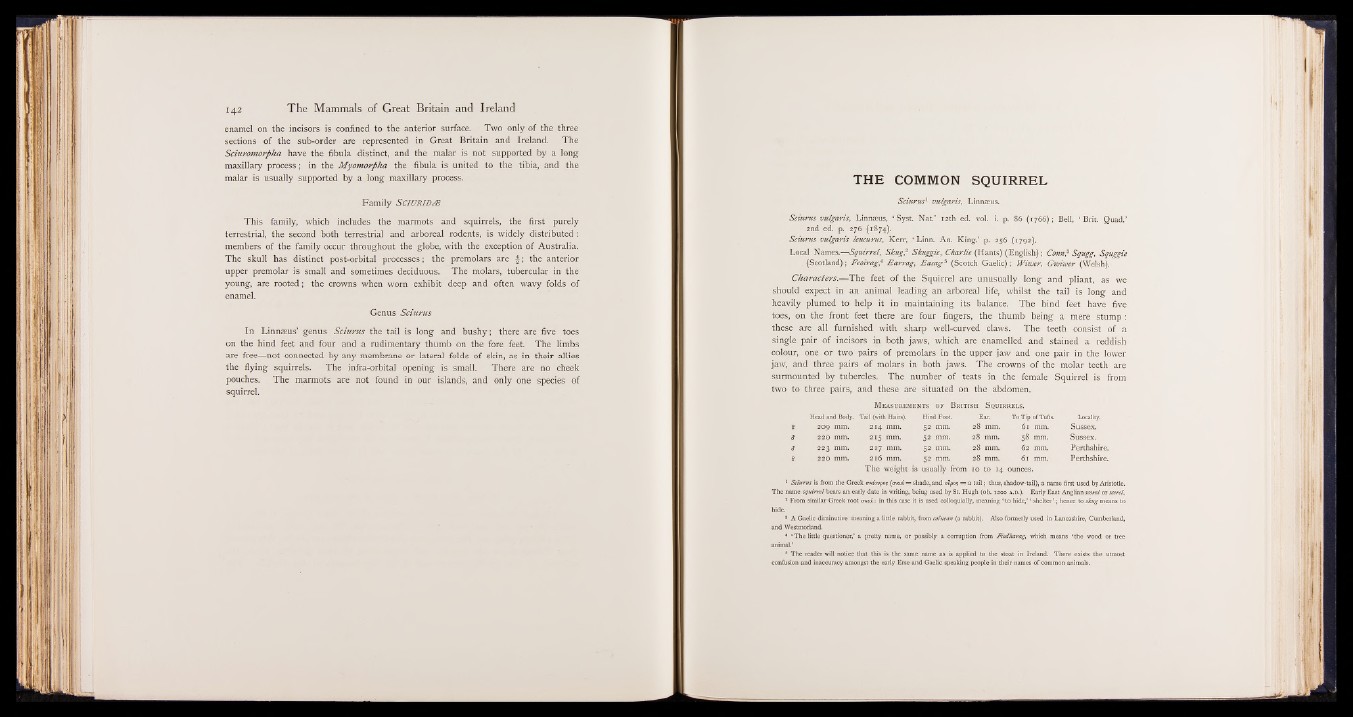
enamel on the incisors is confined to the anterior surface. Two only of the three
sections of the sub-order are represented in Great Britain and Ireland. The
Sciuromorpha have the fibula distinct, and the malar is not supported by a long
maxillary process; in the Myotnorpha the fibula is united to the tibia, and the
malar is usually supported by a long maxillary process.
Family S ciu r id je
This family, which includes the marmots and squirrels, the first purely
terrestrial, the second both terrestrial and arboreal rodents, is widely distributed-:
members of the family occur throughout the globe, with the exception of Australia.
The skull has distinct post-orbital processes; the premolars are f ; the anterior
upper premolar is small and sometimes deciduous. The molars, tubercular in the
young, are rooted; the crowns when worn exhibit deep and often wavy folds of
enamel.
Genus Sciurus
In Linnaeus’ genus Sciurus the tail is long and bushy; there are five toes
on the hind feet and four and a rudimentary thumb on the fore feet. The limbs
are free—not connected by any membrane or lateral folds of skin, as in their allies
the flying squirrels. The infra-orbital opening is small. There are no cheek
pouches. The marmots are not found in our islands, and only one species of
squirrel.
THE COMMON SQUIRREL
Sciurus1 vulgaris, Linnaeus.
Sciurus vulgaris, Linnaeus, ‘ Syst. Nat.’ 12th ed. vol. i. p. 86 (1766); Bell, ‘ Brit. Quad.’
2nd ed. p. 276 (1874).
Sciurus vulgaris leucurus, Kerr, Linn. An. King.’ p. 256 (1792).
Local Names.—Squirrel, Skug,2 Skuggie, Charlie (Hants) (English); Conn? Squgg, Squggie
(Scotland); Feoirag? Earrag, Easag5 (Scotch Gaelic); Wiwer, Giviwer (Welsh).
Characters.—The feet of the Squirrel are unusually long and pliant, as we
should expect in an animal leading an arboreal life, whilst the tail is long and
heavily plumed to help it in maintaining its balance. The hind feet have five
toes, on the front feet there are four fingers, the thumb being a mere stump:
these are all furnished with sharp well-curved claws. The teeth consist of a
single pair of incisors ip both jaws, which are enamelled and stained a reddish
colour, one, or two pairs of premolars in the upper jaw and one pair in the lower
jaw, and three pairs of molars in both jaws. The crowns of the molar teeth are
surmounted by tubercles. The number of teats in the female Squirrel is from
two to three pairs, and these are situated on the abdomen.
M e a su r em en ts of B rit ish S quirrels.
Head and Body. Tail (with Hairs). Hind Foot. Ear. To Tip of Tufts. Locality.
? 209 mm. 214 mm. 52 mm. 28 mm. 61 mm. Sussex.
9 220 mm. 215 mm. 52 mm. 28 mm. 58 mm. Sussex.
S 223 mm. 217 mm. 52 mm. 28 mm. 62 mm. Perthshire.
9 220 mm. 216 mm. 52 mm. 28 mm. 61 mm. Perthshire.
The weight is usually from 10 to 14 ounces.
1 Sciurus is from the Greek tridovpos (triad = shade, and ovpos = a tail; thus, shadow-tail), a name first used by Aristotle.
The name squirrel bears an early date in writing, beiug used by St. Hugh (ob. 1200 a.d.). Early East Anglian scorel or scerel.
2 From similar Greek root <naa: in this case it is used colloquially, meaning ‘ to hide,’ ‘ shelter ’ ; hence to skug means to
3 A Gaelic diminutive meaning a little rabbit, from coinean (a rabbit). Also formerly used in Lancashire, Cumberland,
and Westmorland.
4 ‘ The little questioner,’ a pretty name, or possibly a corruption from Fiodharag, which means ‘ the wood or tree
animal.’
6 The reader will notice that this is the same name as is applied to the stoat in Ireland. There exists the utmost
confusion and inaccuracy amongst the early Erse and Gaelic speaking people in their names of common animals.